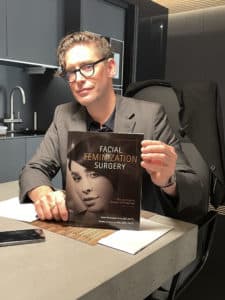What is Forehead and Brow Feminization?
The forehead and brow are one of the most important facial features for gender expression and therefore critical for facial gender confirmation. There are notable differences between men and women – in a hairline pattern, the eyebrow shape, the size of the eyes, and the overall shape of the forehead.
How does Forehead Contouring and Reduction enhance Facial Feminization?
Forehead feminization is one of the most important surgical procedures included in facial feminization surgery (FFS) because the forehead encompasses almost 35-40% of the entire face surface, and essentially dominates and aesthetically balances all other facial features.

Read Our Book
The wait is over! Dr. Deschamps-Braly’s new book “Facial Feminization Surgery: The Journey to Gender Affirmation” is back and available now. This second edition covers the advances in facial feminization as well as helpful patient stories and is a great resource for FFS patients and their loved ones.
LEARN MOREThe aim of forehead feminization via contouring and reduction within the context of facial gender confirmation is to create a more feminine, “softer” forehead, and reduce the heavy appearance of the male brow. Contouring, along with scalp advancement (hairline lowering) significantly changes the look of a male forehead to become more naturally feminine in appearance. Additionally, any existing congenital facial asymmetries can also be improved by forehead contouring. The procedure shapes the forehead and the bones around the eye sockets, minimizing the heavier bony ridge of a masculine-looking forehead. Contouring “opens up” the appearance of the eyes, helping to transform and feminize the forehead.
How is Forehead Contouring for Facial Gender Confirmation Surgery performed?
During your initial surgical consultation, Dr. Deschamps-Braly will make a plan for the correct contour and desired shape of your forehead. Surgical planning is undertaken based on science, artistry, extensive facial gender confirmation experience, and aesthetic intuition. He will catalog a battery of measurements during your consultation which allows him to plan for the most appropriate approach to your surgery. He also utilizes custom-made precision instruments to reshape the hairline, forehead bones, brows, and eye regions to ensure a more feminine appearance.
The procedure begins with an incision either right at, or just behind, the hairline – depending on whether or not the hairline position needs to be repositioned. The exact procedure varies from patient to patient, but most often the brow bone is osteotomized and reconstructed to reduce the size of the forehead, and the orbital bones are shaped to modify masculine characteristics. The frontal bone (between the eyebrows) is removed, shaped, and then reattached so that it does not interfere with the underlying sinus cavity. Forehead contouring is often performed in conjunction with a brow lift or hairline restoration because of the location where the incisions are made.

Which is Better: Stainless steel or Titanium?
We prefer to use non-magnetic stainless steel wire for reattaching the forehead bone. In part, because this type of wire does not create unwanted delays in airport security, or issues during an MRI if one is needed in the future. While we have had great experiences with titanium plates and screws overall, and our surgical practice has used them since the 1980’s (when the first commercially available titanium plates and screws were introduced), we do not find them appropriate for forehead surgery. If the forehead needs reshaping, or a ridge or concavity needs filling, the doctor will use a biologically inert synthetic material to create a more rounded feminine shape.



